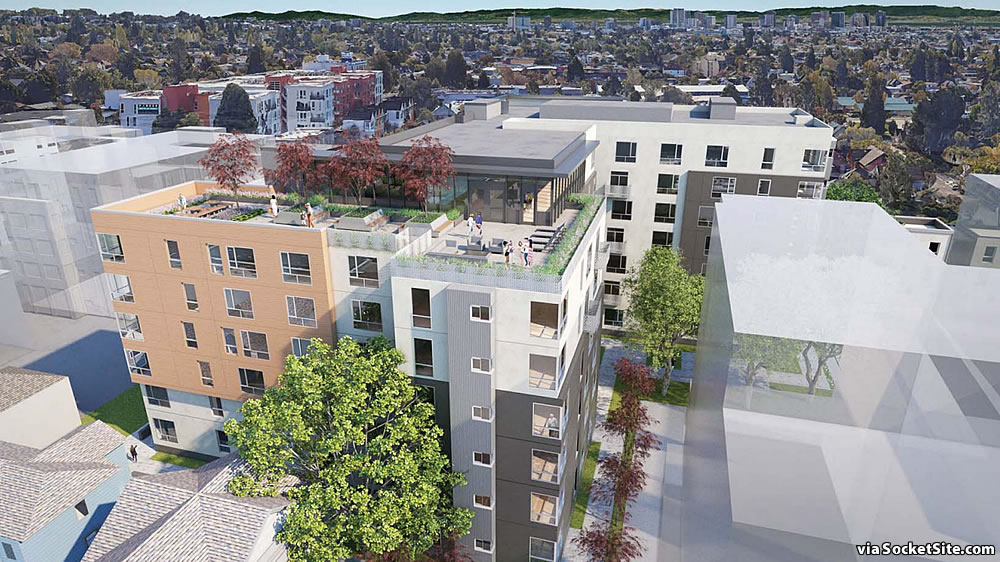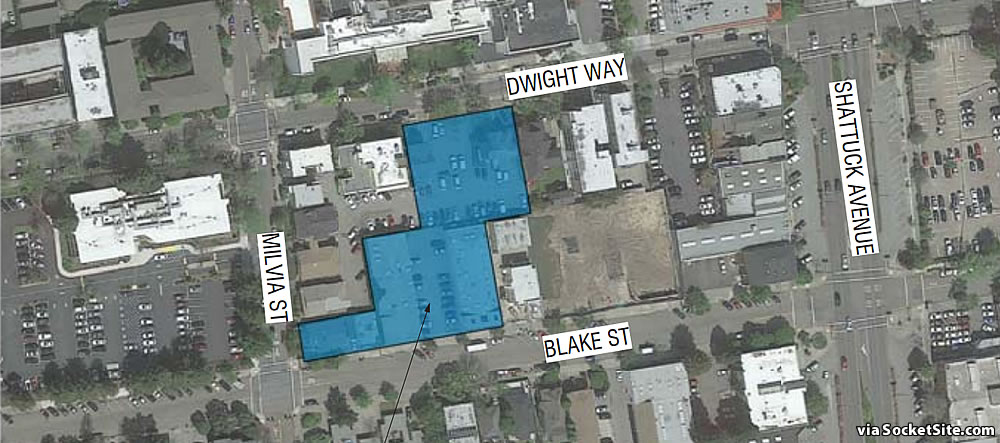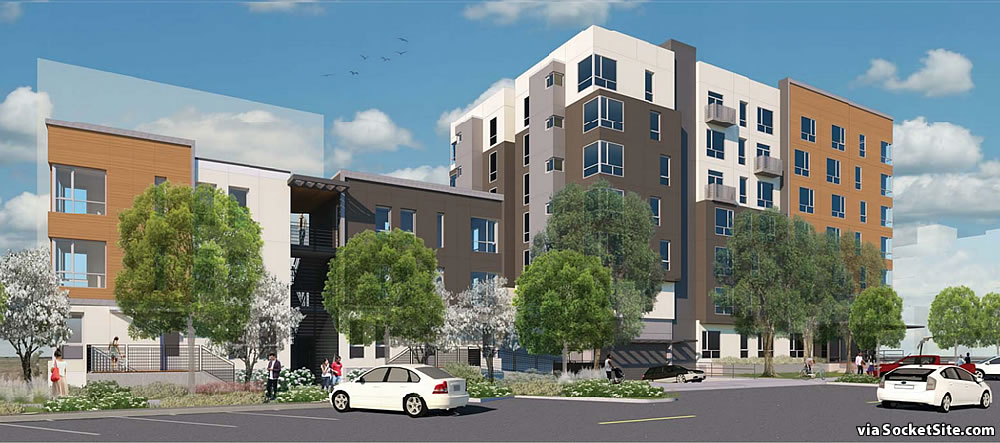As proposed, seven Berkeley parcels fronting Blake Street and Dwight Way, between Shattuck Ave and Milvia Street, will be merged and two new residential buildings would rise up to 82 feet in height upon the 2015 Blake Street site, with a three-story building on the corner of Blake and Milvia and a seven-story building mid-block.
The development would yield a total of 161 residential units with a basement garage for 93 cars and a shared roof deck upon the mid-block building, as designed by Lowney Architecture for the Laconia Development team.
And while four of the existing buildings on the site would be demolished, two of the buildings, 2012 and 2020 Dwight, would be shifted towards the street and together, and restored, the plans for which will be presented to Berkeley’s Zoning Adjustments Board next week with an Environmental Impact Report (EIR) for the project in the works and a planned Density Bonus for building over 65 feet in height, which is the maximum height for which the site is zoned.




124 studios, 6 1br, and 31 2br. I support the development but it definitely is shifting the mix away from family households toward single people.
I lived on this block while at Cal — it’s mostly all college students around there and our Victorian had 3 units all occupied by college students also. So studios probably free up some of the regular housing stock for families
downtown berkeley is the perfect place for high density of small units without parking. Anything to reduce demand on the city’s general housing supply by the Cal student body. Areas further from campus are better for larger units. The unit mix here seems absolutely appropriate.
In fact I would say the amount of parking in this project (more than 1 space for every two units) seems excessive. When I was an undergrad at Cal I knew very few people with cars. Much less than half the people.
I didn’t think many families lived in downtown Berkeley to begin with.
I don’t understand the design. It seems like they didn’t try very hard or mixed together a lot of different ideas and voted on a compromise.
I don’t usually pot shot building ideas, but come on. What is a good version of what they are trying to achieve? This looks terrible.
Looks like another backdoor student housing building, honestly. Which isn’t bad, they need more of those, but…
This building is to accommodate the mass influx of students that the University said they would cap at a much lower level.
The more housing we build the more students the University will admit. It’s no win for the residents.
Seems good for society though. I’m quite sure the University existed when current residents moved to Berkeley.
That comment has to win the socketsite “best zinger posted by a real estate agent” award for this week.
I am not a real estate agent.
It’s telling that you can’t comprehend that someone would prioritize housing policy that benefits wider society rather than individual interests without that person directly benefiting from said housing.
Isn’t she right though? The school was there before the town, wasn’t it? Why would anyone move to a college town and then complain about there being too many students? :))))
This is just more of that typical boomer entitlement that we all know and love. “I showed up, now pay me!”
Also, Cal as a state school has no control over the number of students it admits. These numbers are driven by the state and are based on the number of Cal grads the state thinks it needs in order to drive economic growth.
Yes, she is correct. The University was established in 1868 and everybody knows it was there before the city. That is why it’s such a great zinger.
Here’s why UCB went 60 years without building a dorm while there was a nonstop building surge on the campus. no other state flagship university provides as few beds for its students. all the while the rental market was wrecked.
Well, you can thank the Berkeley anti-housing community for that. They have been successfully blocking new buildings, especially student housing, in Berkeley for about that long.
And while the young professionals who would have preferred to live in Berkeley could always opt for a newly-built greenfield suburb like Dublin or Pleasanton, students had/have little choice but to pay the shortage-induced extortionist Berkeley rents.
There was no way for prices to go but up into the stratosphere.
The University is exempt from local regulation – at least officially – so that seems a dubious argument. And when they DO move forward, the effort is clumsy.
Yeah, regulation-shmegulation. What does that have to do with the ability of local opposition to block housing construction? As soon as a project is announced the pitchforks come out. Show me just one Berkeley project in, say, the last 30 years that wasn’t hobbled by the efforts of the local “anti-development at all costs” crowd, seriously.
Actually, if UCB built dorms on campus, then to the extent that there is such a group of people who could be credibly called “the Berkeley anti-housing community”, such a group’s influence could have been avoided. As a state agency, if UCB built dorms on campus they would not be subject to The City of Berkeley’s approval.
You’re kidding, right? Are you like a recent transplant here? 🙂 Anyway, I thought the Berkeley anti-housing community was famous the world over. Even the New York Times wrote about it. Remember the Berkeley zuccini lady?
They’re not one group but a constellation of various groups, some with built-in non-profit and political orgs. And they are very adept at finding various ways to kill off or slow down projects into oblivion. There are dozens of major ones, ranging from overtly SFH property value preservation-oriented ones, all the way to faux lefty ones which kill projects by always demanding just a little more subsidized units than they know that developer can afford. The very threat of having to deal with them keeps most of the necessary development away. Plus you have the sympathetic City Council which comes up with ever more creative ways to stop development as well, both project-by-project and legislatively.
Just a few days ago the People’s Park group demolished some fencing for an upcoming Cal dorm development. Another group is blocking a graduate dorm on the North side of campus; I think those are suing on some pretence or another. Various groups have already sprung up to defeat the development of each of the, I think, eleven potential dorm sites Cal has identified.
All of this is chronicled in the local newspapers. You can look it aaaall up.
And of course everything you wrote was orthogonal to my point, which was that UC Berkeley could have gone on a building boom on campus for housing students (on campus) at any time over the bulk of the past half-century and completely avoided any resistance in the City of Berkeley because those projects would have not been subject to City planning constraints, and hence, impervious to the so-called “Berkeley anti-housing community”.
Your multiple posts on this thread read like you are a person pimping for development interests.
This stretch of Blake is shaping up to be one of the more bizarre looking blocks in Berkeley. The corner of Shattuck and Blake features a landmarked two story stucco building that is a shell of its former self (it used to house the Japanese American-owned University Laundry). Rising up behind that is the five story apartment development called The Blake (as featured on SocketSite when it was approved as The Roost). The Blake steps down to 3 stories mid block. This development then rises up 7 stories, before stepping down to 3 stories at Milvia.
the Milvia boundary is not 3 stories. BayRock has entitlements for a 6 story Senior Housing community. It is a stunning Class A design that will “finish” the block with more quality materials and rhythm. The senior use creates little if any cars.